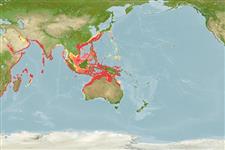Environment: milieu / climate zone / depth range / distribution range
экология
морской ассоциированный с рифами; пределы глубины 10 - 400 m (Ref. 89707). Tropical; 35°N - 32°S, 29°E - 150°E (Ref. 5222)
Indo-West Pacific: Red Sea and East Africa to southern Japan and Queensland, Australia. Also from the Paracel Islands in the South China Sea. There are no records from Madagascar, Mauritius, Maldives, Laccadives, and Sri Lanka, Indonesia, and the Philippines.
Length at first maturity / Size / Вес / Возраст
Maturity: Lm ?, range 99 - ? cm
Max length : 200 cm TL самец/пол неопределен; (Ref. 2872); наибольший вес (опубликованные данные): 110.0 kg (Ref. 9710)
колючие лучи спинного плавника (общее число): 11; членистые (мягкие) лучи спинного плавника (общее число): 14-15; колючие лучи анального плавника 3; членистые (мягкие) лучи анального плавника: 8. Distinguished by the following characteristics: body depth contained 2.9-3.5 times in SL; head length 2.3-2.6 times in SL; slightly convex interorbital area; straight dorsal head profile; rounded or subangular preopercle, slightly enlarged serrae at angle; almost straight upper edge of operculum; posterior and anterior nostrils subequal in size; maxilla reaches to or beyond vertical at rear edge of eye; 2-6 rows of teeth on midlateral part of lower jaw (Ref. 89707).
Mainly found in deep reef channels and seamounts, in current prone areas (Ref. 48635). Juveniles may be found in tide pools (Ref. 5222). Feeds on reef fishes, skates, crabs, and spiny lobsters (Ref. 5222). Considered to be exceedingly territorial and very aggressive towards intruders. Vulnerable to spear fishers (Ref. 5222). Hand fed by divers in certain areas, but potentially dangerous to the inexperienced. In the Hong Kong live fish markets (Ref. 27253). Solitary (Ref 90102).
Life cycle and mating behavior
половая зрелость | размножение | нерест | икра | Fecundity | личинки
Heemstra, P.C. and J.E. Randall, 1993. FAO Species Catalogue. Vol. 16. Groupers of the world (family Serranidae, subfamily Epinephelinae). An annotated and illustrated catalogue of the grouper, rockcod, hind, coral grouper and lyretail species known to date. Rome: FAO. FAO Fish. Synop. 125(16):382 p. (Ref. 5222)
Статус Красного Списка МСОП (Ref. 130435)
Угроза для людей
Harmless
Использование человеком
рыболовство: рыболовство как средство для существования; объект спортивного рыболовства: да
дополнительная информация
ссылкиаквакультура (рыбоводство)особенности рыбоводствастепень растяжениягенетикаElectrophoresesнаследуемостьболезниобработкаNutrientsMass conversion
инструменты
Специальные отчеты
Скачать в формате XML
ресурсы в Интернет
Estimates based on models
Preferred temperature (Ref.
123201): 16.8 - 27.7, mean 23.9 °C (based on 619 cells).
Phylogenetic diversity index (Ref.
82804): PD
50 = 0.5000 [Uniqueness, from 0.5 = low to 2.0 = high].
Bayesian length-weight: a=0.01479 (0.00762 - 0.02872), b=3.05 (2.89 - 3.21), in cm total length, based on LWR estimates for this species & Genus-body shape (Ref.
93245).
Trophic level (Ref.
69278): 4.2 ±0.68 se; based on food items.
Generation time: 8.5 ( na - na) years. Estimated as median ln(3)/K based on 1
growth studies.
устойчивость к внешним воздействиям (Ref.
120179): низкий, минимальное время удвоения популяции 4.5-14 лет (Preliminary K or Fecundity.).
Fishing Vulnerability (Ref.
59153): High to very high vulnerability (66 of 100).
Nutrients (Ref.
124155): Calcium = 11.1 [5.0, 25.1] mg/100g; Iron = 0.368 [0.188, 0.752] mg/100g; Protein = 18.8 [17.2, 20.3] %; Omega3 = 0.121 [0.069, 0.216] g/100g; Selenium = 73.4 [39.2, 145.5] μg/100g; VitaminA = 82.7 [22.4, 294.4] μg/100g; Zinc = 0.801 [0.547, 1.169] mg/100g (wet weight);
